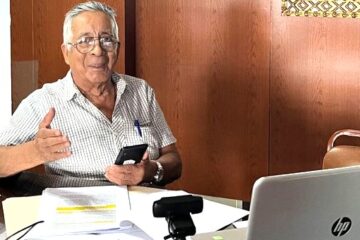By Lechelle Barron

Sandra Andino held early this month a reception for the opening of her photo documentary exhibition to showcase additional pieces and portraits to her project. The exhibition “Afro-Latino in Philadelphia: Stories from El Barrio” will be on display until January 9, 2016, at Taller Puertorriqueño’s Lorenzo Homar Gallery exhibition hall in North Philadelphia.
The new additions to the exhibit are photographs that document Andino’s own cultural discovery of understanding and learning about her Afro-Latino identity. “The seed for this idea was conceived a few years ago when I began searching my family roots and revisiting chapters of my childhood and adult life that were marked by racial experiences,” said Andino, an Afro-Puerto Rican photographer and cultural anthropologist. “For many years, I didn’t speak or share these incidents until I began to hear similar stories from other Afro-Latinos and Afro-Latinas. It was in Philadelphia at an Arturo A. Schomburg Symposium at Taller Puertorriqueño that I knew I had to do this project.”

In this exhibit, she has also added updated biographies, and created an audio tour through CultureSpots at this website, http://spts.us/negraluz/afro-latino-philadelphia so that her audience can listen to the interviews of each person she photographed. “There are 8 or 9 30 X 44 portraits of Afro-Latinos that I interviewed in the community, with the photos I presented an excerpt of some of the most salient things that stood out in the interview that I think are important to the photos,” said Andino. “I call it a photo documentary because its documenting a component of our history, of our people, of our community, it just wasn’t photos, I really wanted this to be kind of an educational piece for people to read and know about the lives of the people that they were viewing in this exhibit, and to also read about their experiences as Afro-Latinos, whether it was positive or negative or whether there was a story that really had an impact on that person.”

Andino skillfully uses a different approach to storytelling through each photograph and piece in the exhibit. This project is not only a documentation of Afro-Latinos in Philadelphia, but also goes against the stereotypes of the Afro-Hispanic community as a whole, by showing how each subject photographed is using their education and talents to contribute to the city through community service.
Jesse Bermudez, an award-winning Afro-Puerto Rican and Cuban musician is photographed with his guitar. In addition to his professional achievements in the Latin music world, he is an active leader in the Latino community in Philadelphia. In 1982, he founded (AMLA) the Association of Latin American Musicians, which is an organization aimed to help young musicians and performers in the community, and have created programs for the city’s public schools. He is so respected in the community that on July 8, 2015, The City of Philadelphia named this day “The Jesse Bermudez Day” for his success in Latin music and his community service.
Growing up in Philadelphia, Bermudez knows firsthand the challenges of being a Black and Latino youth. “Being in a black neighborhood you had to be a little bit tougher in my case, because once they identified that you’re from another culture they kinda like always on top of you,” said Bermudez. “I remember they use to want me to speak Spanish all the time, but then after a while it got on my nerves. For me, there was a lot of black folks that didn’t believe I was Latino.”
Emilio Tapia, who is photographed with the Bomba drum, which is a representation of his Afro-Puerto Rican identity, describes a similar childhood experience growing up as an Afro-Latino in inner city Philadelphia. “It was hard for me then especially as a middle school kid, because you’re trying to find yourself. Here a lot of youth, they divide themselves, the Blacks with the Blacks, and the Puerto Ricans with the Puerto Ricans in North Philly, and they talk bad about them, look at them morenos,” said Tapia. “Then I had let my hair grow, and had got cornrows, braids, and I was getting so much grief from the Puerto Ricans, “You think your Black?” “You want to be Black”, and I had some Black friends who talk bad about Puerto Ricans, and I’m looking like, “Yeah, I am Black, and don’t you know you’re the same.”
Maria E. Mills-Torres, who is Afro-Puerto Rican, said her mission as a Multicultural Curriculum and Language Specialist in the Philadelphia School District is “to speak out and make people aware, discrimination and racism is done in such a way that the individual who is doing it sometimes doesn’t realize it.”
“This is one of the reasons why I am really committed to doing diversity workshops for our district and trying to get our teachers to understand diversity issues, because a teacher who doesn’t know his or her own biases is affecting what’s happening to our kids in that classroom,” said Torres. She has also helped create a Teacher Educational Guide about the life of Arturo Schomburg, who was an Afro-Puerto Rican historian and an activist of the Afro-Latino and Afro-American communities. “This booklet was used for classroom teachers in terms of diversity, we wanted to be able to show Puerto Ricans also have connections to our African Diaspora. Also, because the student population of the School District is mostly African-American, we wanted to make sure that teachers could see that this is something that we could bring together to the Puerto Rican and the African American students to recognize that they have things in common,” she adds.
Lucas Rivera, who is Afro-Puerto Rican, and in the portrait with his wife Rubi Pacheco-Rivera, is also an educator and the director of Grand Park at The Music Center in Los Angeles. He explains his connection with his Afro-Latino identity. “For me, my dreads were a representation of my African roots, of who I was outside my skin and in my blood. Those visual identifications of who I was got to a point where I started becoming introverted as an Afro-Latino because it was hard to be an Afro-Latino in our community,” said Rivera. I think now that I had a family that respected me for who I was, not for what I look like, I started to open a lot more as the Afro-Latino, and working on my craft a lot more, and every moment I get to share it, I share from that perspective,” he adds.
Rachel Rojas, who is photographed on a couch next to her Bomba clothing, is also a music and dance director of her Bomba and dance ensemble, Raíces de Borinquen. Rojas connects her Afro-Latina identity with the Puerto Rican style music Bomba, which is a combination of sounds from the Island, the Spanish, African and Taino cultures. “When we started to hear Bomba, it captivated us,” said Rojas. “That black man, that we had inside, that black woman, just exploded in all of the family, because the one who had never danced, the one who had never played, the one who had never done anything, dared to do it all, to dance, to sing, this is what I’ve wanted since I was a little girl, to be in a dance group, but a folkloric one, and I wanted to have my children with me, out of the streets, out of the drugs, out of trouble,” she adds.

Another portrait included in this exhibit, is a photograph of Evelyne Laurent-Perrault, an Afro-Venezuelan, who is one of the most influential Afro-Latinas in Philadelphia. A former wildlife biologist and researcher, Evelyne’s passion for history, along with her experiences with racism as a child and as an adult in Venezuela and Philadelphia, inspired her to pursue a doctoral degree at New York University in Afro-Latin America & Caribbean History, which she completed this year. “As a little girl, my mother and father were constantly with other Haitians who were also isolated ethnically. I had all those questions inside, but I didn’t have the language,” said Laurent-Perrault. “So, meeting Chucho was like Wow, someone from Barlovento, a descendant of the enslaved in Venezuela, and he has led the Afro-Venezuelan movement of the last 20 years. Finally, I find a connection with someone who can help me reflect and chew on these issues. Especially, given that people would always say things like, “Well, you’re Haitian” or “Well, the black person in Venezuela doesn’t feel that way,” she adds.
Joacim Fuentes Rojas, an Afro-Puerto Rican, and Karla E. Mota-Rojas, an Afro-Puerto Rican and Dominican, are photographed together, and are both active community leaders in Philadelphia, and work as mentors and organizers at various events that are specifically geared towards Latino youth.
This photo exhibition is proof of Afro-Latinos “existence” in American culture. It’s an educational work of art that shows Afro-Latinos claiming their identity as being a part of both Black and Latino culture, and acknowledging their contributions and accomplishments in the City of Philadelphia.
jueves, abril 25



